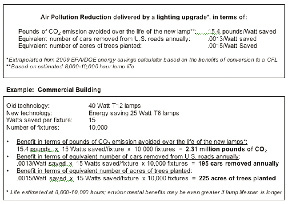Sure, building professionals are well-versed in analyzing the financial impact and cost benefits of the lighting upgrades they conduct. But what about the all-important environmental benefits of a lighting upgrade? Imagine how compelling it would be to be able to measure, in very quantifiable terms, the green contribution that a facility's lighting upgrade is making to the environment.
The adverse effects of our nation's current levels of electricity use on the environment are staggering. Recent DOE data reveals that 2.5 billion tons of pollutants including sulfur dioxide, nitrogen oxides, and carbon dioxide are emitted into the atmosphere every year as a by-product of utility electricity generation. Over time, their emission has waged profound negative effects on the environment, contributing to the depletion of the ozone layer, increased levels of acid rain, and the heightened prevalence of cardiac and respiratory ailments among the American population.
Lighting upgrades, however - involving such products as energy-efficient lamps, ballasts, and lighting controls - make great strides towards offsetting these adverse effects on the environment and reducing our ecological footprint. And by using the following formulas derived from a 2009 EPA energy savings calculator, building owners and real estate professionals can build this critical element into the lighting upgrade proposals they develop for their executive teams - identifying the "green" aspect of the project, or the CO2 reduction and air pollution reduction equivalence (in terms of acres of trees planted and cars removed from U.S. roads) that the lighting upgrade is driving.
The chart (above) of "green" formulas can apply to any size lighting upgrade project involving any lighting technology.
On top of their attractive financial benefits, energy-efficient lighting upgrades within the country's 5 million commercial buildings do a great deal more than reduce energy costs, improve productivity, and enhance system quality....they also significantly benefit the environment and help conserve precious natural resources. So don't hesitate to include an assessment of the green element in your analysis of a lighting upgrade using the simple guidelines above....it will not only enhance the quality of the proposals made to your management team but will help your organization understand how their actions are helping to drive a more energy-efficient future for generations to come.
Susan Bloom, a freelancer and consultant, is an 18-year veteran of the lighting and electrical products industry.
Tags:
 (1).png)









